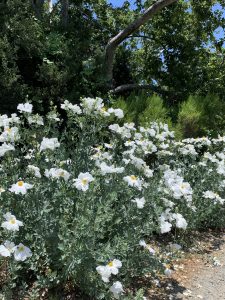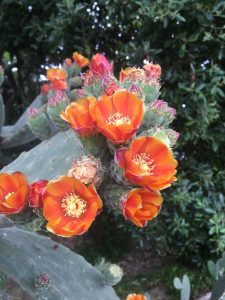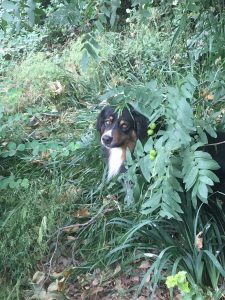 As you are reading this in June 2019, your location in southern California will be the determining factor as to whether you are enduring temperatures near 100 or hoping the sun will break through a thick marine layer. With a not-yet-warm ocean and very hot conditions inland, “June gloom” can set in near the coast with low clouds, fog, and a cooling afternoon breezes lasting for days. Meanwhile inland, people definitely know that summer has arrived. Regardless of temperatures, gardeners can all share in the knowledge that the days are long and native plants are transitioning to deal with the summer heat. We had a wet winter/spring season. Let’s look into what should be done to help the plants with their transition.
As you are reading this in June 2019, your location in southern California will be the determining factor as to whether you are enduring temperatures near 100 or hoping the sun will break through a thick marine layer. With a not-yet-warm ocean and very hot conditions inland, “June gloom” can set in near the coast with low clouds, fog, and a cooling afternoon breezes lasting for days. Meanwhile inland, people definitely know that summer has arrived. Regardless of temperatures, gardeners can all share in the knowledge that the days are long and native plants are transitioning to deal with the summer heat. We had a wet winter/spring season. Let’s look into what should be done to help the plants with their transition.
No more rain. A summer thunderstorm or cloud break from tropical origins always remains a possibility, but we cannot expect any soil soaking rain until fall. That’s just the way it is in California.
And, BTW have you noticed the toyon this year? We can’t remember such a profuse bloom! The crop of winter berries should be one for the record books too, but we’ll have to wait and see.
Watering
Yes. Time to start. Find a few days when a heat wave is not in the forecast. Set the sprinklers to run, or move a hose-end sprinkler around, or hand water, so that you apply the equivalent of 1-1.5” of precipitation. With most sprinkler systems, you will need to run the sprinklers for 60-90 minutes, and the best way to do this is to water early in the morning 20-30 minutes each day, three days in a row. Don’t do it during a heat wave. Do it approximately once a month. This “Deep Soak” method is described more fully here: https://californianativeplants.com/wateringnativeplants/
Related to Watering
If the June watering described above is your first watering of the year, I hope you will also check the system while it is running to make sure you have no breaks, broken sprinklers or clogged lines after 6-7 months downtime. Moving into summer, you can repeat the pulse/cycle soak technique approximately once every 3-4 weeks. Water in anticipation of heat waves, not during the actual event. In the watering guide mentioned above, you will also read about “Refreshing Sprinkles” which you do in the early evening, basically wetting the leaves and soil surface a couple of times a week, without watering the root zone. Again, see: https://californianativeplants.com/wateringnativeplants/
Pruning
Most of your seasonal pruning, in preparation for the heat of summer, is finished if you had a chance to get out in your garden in May. Subshrubs like sunflower, sage, coyote brush, and any number of spring flowering plants should be headed back and then left alone until fall. Remember, most woody shrubs like coffeeberry, lemonade berry, sugar bush, toyon, and manzanita will not require shaping or heading back, but will benefit from pinching or pruning the terminal bud of each branch to encourage side shoots. Best to leave any major thinning until fall. Prune ceanothus seed heads off if you haven’t done so already. There’s a manzanita variety to meet the specs on every size and shape, so they don’t need pruning except to thin the inside of the large shrub/tree types in fall. Don’t forget to sanitize your shears with periodic dips in 10% bleach solution.
Weeding
Summer weeds (spurge, ragweed, telegraph weed, dandelion, etc.) will be unnaturally strong if you unnaturally water too frequently. They will weak and wimpy and easy to eliminate if your watering schedule is right… a deep soak only every 3 to 4 weeks. Don’t water the weeds!
Mulching/Top dress
The layers of whatever top dress you have in place can be occasionally turned and broken up to let some fresh air in. On established gardens, do not bring in any new, fresh, green, organic mulch or compost at this time; it’s too hot. If you are planting new plants and you mulch the soil surface, keep the mulch away from the stems and branches of the new plants.
Feeding
Why are my leaves yellow? This question comes up in June for citrus, certain ornamental non-native plants (i.e.; gardenia, camellia) and (rarely) a few established or potted natives. Yellow or off-green leaves can be caused by many factors, like a dry root zone or an over-saturated root zone, or nutrient deficiency. If the yellowing on rhus, ceanothus, ribes, or myrica is showing up as mottled leaves, green veins on yellow leaves, or an overall peaked, tired color on coyote brush, encelia, or strawberry, it may be that the copious winter rains leached the nutrients away and your soil is binding up available iron, zinc, and manganese. Nitrogen might be in poor supply or unavailable. Natives are really efficient at finding nutrients, so all you have to do is spread some all-purpose plant food around the root zone (following label instructions, but apply less), then thoroughly water it in. If you see no signs of nutrient deficiency, don’t feed at this time; wait until fall. Nutrient deficiency is much more common with non-native plants, especially in June.
Troubleshooting – Varmints, Pests, and Diseases
As the new growth hardens on the plant (warm, long days, natives getting ready for summer) you will see fewer plant pests like aphid, or scale. Argentine ants can harbor those bad guys or undermine root zones with big air pockets (their nests). Control/eliminate. Populations of bunnies and squirrels should be stabilizing after the big spring flush. Avoid root disease problems by watering according to this: https://californianativeplants.com/wateringnativeplants/
See previous years’ articles for pest control details specifically for spring and summer months.
Annual Wildflowers
As the last of last spring’s blooms fade, march into your garden and do the wildflower stomp. Mangle up the plants and turn them into organic topdress with the seeds in place to lay dormant until fall. If you are the more meticulous type, collect and save the seeds in paper bags in a cool spot indoors, so you can sow them in the fall.
 Adding New Plants
Adding New Plants
Near the coast or anywhere in the shade you can handle native plants all year long. If you have room for a few desert or desert-like specimens, now is the time to plant them as they love warm weather. Come on over. Tree of Life takes on a new look with the long days. Watch our event calendar for special opportunities to enjoy our place after hours this summer.
Engage
Only in June can you stroll into or sit in your garden at 8:30 pm with the sun still up. Enjoy. If earlier in the day, you had to endure mechanical noise and air pollution brought to you by your neighbors’ “gardeners” with their mowers and blowers, we’re sorry. At least those guys are gone by evening. Invite your neighbors over and share with them the peace and beauty of your garden. Hummingbirds will come for sips of nectar before their bedtime, and you can mention your  incredible water savings. And you might also suggest that the whole neighborhood would be a lot quieter and more peaceful if everyone had a California natural garden.
incredible water savings. And you might also suggest that the whole neighborhood would be a lot quieter and more peaceful if everyone had a California natural garden.
From the Garden,
Mike Evans
Questions? Help is just one call or one email away. Call (949) 728-0685 or email (with pictures if you like) our special helpline: gardenhelp@californianativeplants.com
To get our monthly updates sign up for our eNewsletter at this link here.